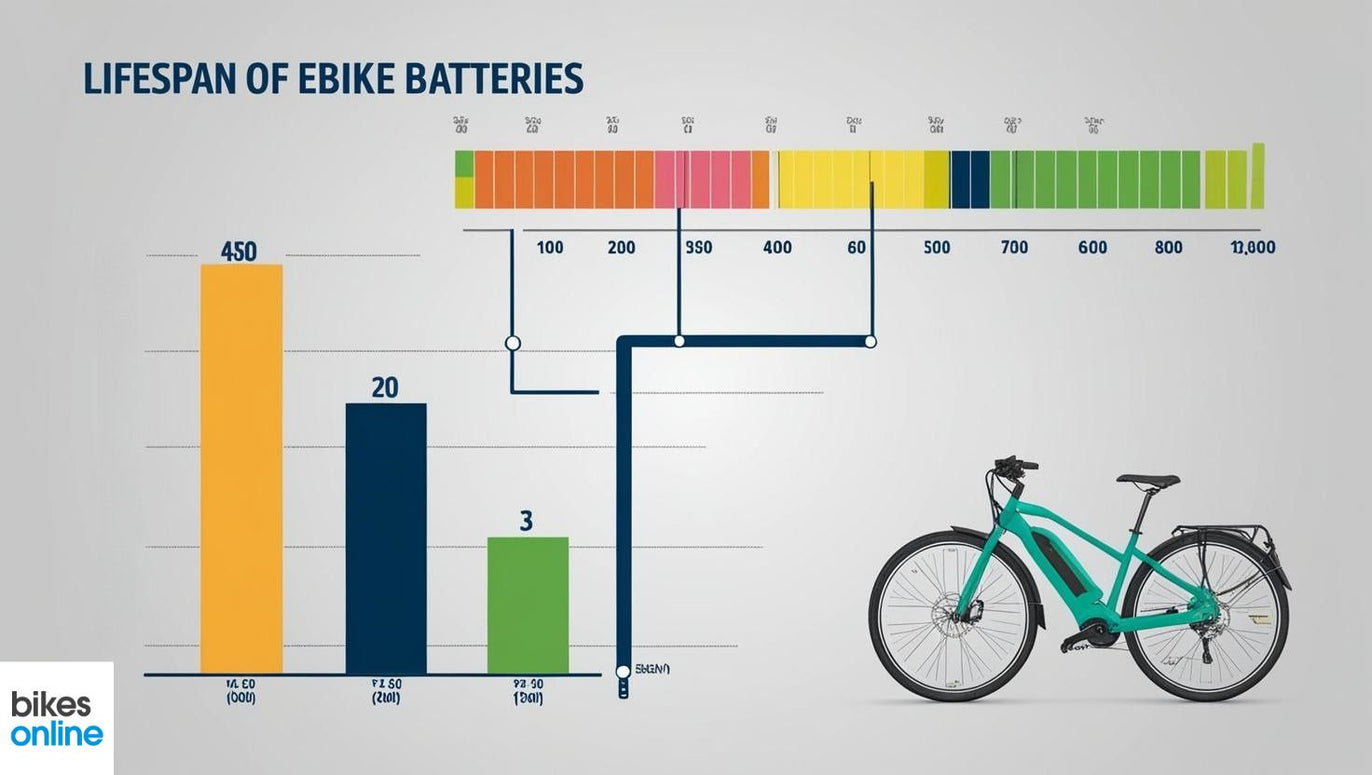How Long Do Ebike Batteries Last?

Electric bikes, or ebikes, have surged in popularity across Australia, offering an eco-friendly, economical, and convenient alternative to traditional transportation. This boom is driven by the diverse landscapes and bustling urban settings of Australia, where ebikes prove ideal for both commuting and leisure. As the number of ebike enthusiasts grows, understanding the longevity and maintenance of ebike batteries becomes crucial.
Battery life is a vital consideration for any ebike owner. It not only affects the bike's range and performance but also impacts long-term costs and usability. In this guide, we will delve into the various aspects of ebike batteries, including types, maintenance, and the factors that influence their lifespan. Our aim is to equip you with the knowledge to enhance your ebike's efficiency and extend its battery life, ensuring a seamless and enjoyable riding experience.
Exploring the Different Types of Ebike Batteries
Ebike batteries are the heart of the electric bike, powering your rides through city streets and rugged trails alike. Understanding the different types of batteries can help you choose the right one for your needs and ensure optimal performance. Here’s a breakdown of the most common types of ebike batteries, along with their pros and cons, particularly focusing on longevity and performance.
Lithium-Ion Batteries
Lithium-ion batteries are the most popular choice for modern ebikes. They are known for their high energy density and efficiency.
Pros:
- Lightweight and Compact: Makes them ideal for reducing the overall weight of the ebike.
- High Energy Efficiency: Offers longer rides on a single charge compared to other types.
- Long Lifespan: Typically lasts between 800 to 1,000 charge cycles before significant degradation occurs.
Cons:
- Cost: Generally more expensive upfront than other types of batteries.
- Temperature Sensitivity: Performance can diminish in extremely cold weather.
Lead-Acid Batteries
One of the oldest types of rechargeable batteries, lead-acid batteries are less commonly used in modern ebikes but are still found in some budget models.
Pros:
- Cost-Effective: Cheaper than lithium-ion and nickel-metal hydride batteries.
- Robust: Tolerant of overcharging and less susceptible to damage from deep discharge.
Cons:
- Heavy: Adds significant weight to the ebike, which can affect handling and portability.
- Shorter Lifespan: Typically lasts about 300 to 500 charge cycles.
- Lower Energy Density: Requires frequent recharging over longer distances.
Nickel-Metal Hydride Batteries
These batteries were once common in earlier generations of electric vehicles, including ebikes.
Pros:
- More Affordable: Less expensive than lithium-ion batteries but offer better performance than lead-acid.
- Less Temperature Sensitive: Performs better in colder temperatures compared to lithium-ion.
Cons:
- Memory Effect: Can lose maximum energy capacity if repeatedly charged after being only partially discharged.
- Weight: Heavier than lithium-ion, though lighter than lead-acid.
Each type of battery offers unique advantages and limitations. Lithium-ion stands out for its efficiency and lifespan, making it the preferred choice for most ebike users seeking performance and durability. However, understanding the specific needs of your riding style and budget will guide you to the best battery choice for your ebike.
Key Factors That Influence Ebike Battery Longevity
Ebike battery longevity is influenced by a range of factors from how the battery is used and cared for, to the intrinsic qualities of the battery itself. Understanding these factors can significantly extend the life of your ebike’s battery, ensuring that it remains functional and efficient for years to come. Here’s what you need to know:
Battery Capacity
- Description: Battery capacity, usually measured in watt-hours (Wh), indicates the total amount of energy a battery can store. Higher capacity batteries tend to last longer both per charge and over their total life span.
- Impact on Longevity: A battery with a higher capacity undergoes fewer charge cycles over time for the same amount of usage compared to a lower capacity battery, potentially extending its overall lifespan.
Usage Habits
- Frequent Short Trips vs. Long Rides: Regular short trips that require frequent stopping and starting can wear out the battery quicker than longer, steadier rides due to the increased load from accelerating often.
- Terrain and Load: Riding on hilly terrain or carrying heavy loads requires more power and can drain the battery faster, impacting its longevity if done frequently without proper battery management.
Charging Practices
- Regular vs. Occasional Charging: It’s advisable to charge the battery regularly rather than letting it completely discharge. Batteries kept at a moderate charge level (20-80%) tend to have a longer lifespan.
- Proper Charging Technique: Using the manufacturer-provided charger and following recommended charging times helps maintain battery health. Avoid leaving the battery to charge overnight or immediately after a long ride when it is still hot.
Environmental Conditions
- Temperature: Extreme temperatures, both hot and cold, can adversely affect battery performance and lifespan. Storing and charging your battery in a temperature-controlled environment is ideal.
- Moisture and Exposure: While most ebike batteries are designed to be somewhat weather-resistant, prolonged exposure to harsh conditions like rain or direct sunlight can degrade the battery’s components faster.
Tips to Optimize Battery Use
- Charge Properly: Avoid charging to 100% if not necessary; aim for up to 80% to extend battery life and only do a full charge once a month to balance the cells.
- Store Correctly: If not using your ebike for extended periods, store the battery at a 50% charge level in a cool, dry place.
- Regular Use and Maintenance: Batteries benefit from regular use and occasional thorough checks. Keep the contacts clean and ensure the battery casing is undamaged.
- Understand Your Bike’s Settings: Utilize eco modes and assist levels appropriately to maximize battery efficiency during rides.
By managing these factors carefully, you can significantly enhance the performance and extend the lifespan of your ebike battery, ensuring it remains a reliable part of your riding experience for as long as possible.
What to Expect from Your Ebike Battery’s Lifespan
Understanding the average lifespan of ebike batteries can help set realistic expectations for the duration your battery will serve you efficiently. This section covers the general lifespan of various types of ebike batteries and provides real-life examples based on typical usage scenarios.
Average Lifespan Statistics
Lithium-Ion Batteries: The most common type used in modern ebikes, lithium-ion batteries typically offer between 800 to 1,000 charge cycles. With proper care, they can last anywhere from 3 to 5 years before their capacity significantly diminishes.
Lead-Acid Batteries: Although less common in newer ebike models, lead-acid batteries usually provide about 300 to 500 charge cycles. They tend to have a shorter lifespan, ranging from 1 to 3 years depending on usage.
Nickel-Metal Hydride Batteries: These batteries can last for about 500 to 800 charge cycles. Their lifespan generally falls between 2 to 4 years, making them a middle ground between lithium-ion and lead-acid batteries in terms of longevity.
Real-Life Examples
Commuter: A commuter who uses their lithium-ion powered ebike daily for a 10 km round trip might typically recharge their battery every two days. Assuming optimal conditions and care, the battery could last for about 4 years.
Weekend Rider: A rider who uses their nickel-metal hydride battery-powered ebike for longer, more intensive rides on the weekends might need to recharge their battery weekly. In such a scenario, the battery may last towards the upper end of its lifespan range, potentially reaching 4 years.
Occasional User: An individual who rides their lead-acid battery ebike occasionally, say for errands or short trips on flat terrain, and recharges the battery less frequently, might find that their battery lasts towards the higher end of the typical range, possibly up to 3 years.
Tips for Maximizing Battery Life
- Regular Charging: Keeping the battery charged regularly without letting it deplete entirely helps prolong its life.
- Proper Storage: Storing the battery in a cool, dry place and avoiding extreme temperatures can prevent premature aging.
- Routine Maintenance: Checking the battery’s condition regularly for any signs of wear or damage can help catch issues before they shorten its lifespan.
By understanding these aspects and managing your battery's usage and care, you can optimize its lifespan, making your ebike a reliable and long-lasting mode of transport.
Best Practices for Ebike Battery Maintenance
Proper maintenance and storage of your ebike battery are essential to prolong its life and ensure it remains efficient and reliable. Here’s a detailed guide on how to maintain your ebike battery, along with recommendations for routine checks and professional maintenance.
Routine Battery Care
- Regular Cleaning: Keep the battery and its connections clean and free from dirt and grime. Use a dry or slightly damp cloth to wipe the battery casing and contacts. Avoid using harsh chemicals or water, which could seep into the battery.
- Charge Correctly: Always use the charger provided with your ebike, and follow the manufacturer's charging guidelines. Avoid overcharging the battery; disconnect the charger once it's fully charged if it does not have an automatic shut-off feature.
- Partial Discharges vs. Full Discharges: It’s better for the battery's long-term health to avoid letting it discharge completely. Try to recharge the battery when it reaches about 20-30% capacity. However, it is beneficial to perform a full discharge once every 30 to 40 charge cycles to calibrate the battery management system.
Storing Your Ebike Battery
- Optimal Storage Conditions: If you're not using your ebike for an extended period, store the battery in a cool, dry place away from direct sunlight or extreme temperatures. Ideal storage temperatures for ebike batteries are between 10°C and 20°C.
- Charge Levels for Storage: Store the battery at a 40-70% charge level. A fully charged or completely discharged battery may lose capacity more quickly when stored for long periods.
- Long-Term Storage: Check the battery charge every few months and recharge it to the optimal storage charge level if necessary.
Routine Checks and Professional Maintenance
- Visual Inspections: Regularly inspect the battery for any signs of wear, damage, or leakage. Check that all connections are secure and that the battery mounts securely to the bike.
- Battery Health Checks: Use a battery management system (if available) to check the health and efficiency of the battery. Look for any significant drops in capacity or performance.
- Professional Servicing: At least once a year, or as recommended by the manufacturer, have your battery checked by a professional. They can perform detailed diagnostics and spot potential issues that may not be obvious.
When to Seek Professional Maintenance
- Performance Decline: If you notice a significant drop in the battery’s range or if it does not hold a charge as well as it used to, it’s time to seek professional help.
- Physical Damage: Any signs of cracking, bulging, or leaks are serious and require immediate professional attention.
- After an Incident: If your ebike and its battery have been involved in an accident, have it inspected by a professional, even if everything seems to be working normally.
Maintaining your ebike battery with these best practices can significantly extend its lifespan and ensure that your rides are smooth, efficient, and enjoyable. Proper care not only saves you money in the long run but also contributes to the overall performance and safety of your ebike.
Recognizing the Signs of Battery Replacement Needs
Knowing when to replace your ebike battery is crucial for maintaining optimal performance and safety. Here are the common symptoms that suggest it might be time to consider a new battery, along with guidance on where to find a replacement and what costs you might expect.
Common Symptoms Indicating Replacement is Needed
Reduced Range: One of the most noticeable signs is a significant decrease in the distance you can travel on a single charge, even after fully charging the battery.
Slow Charging: If the battery takes considerably longer to charge than it used to, or if it fails to reach full capacity despite extended charging times, it may be nearing the end of its useful life.
Power Issues: Experiencing sudden power losses while riding or a noticeable drop in assistance levels can indicate battery problems.
Visible Damage: Swelling, leaks, or any physical damage to the battery case can be dangerous and are clear indicators that the battery should be replaced immediately.
Battery Age: If your battery is approaching or has surpassed its expected lifespan in terms of years or charge cycles, it may simply be time to replace it based on age.
Where to Get a Replacement Battery
Authorized Dealers: Purchasing a replacement battery from authorized dealers ensures you get a genuine product that is compatible with your ebike. This is often the safest option.
Manufacturer Direct: Many ebike manufacturers sell replacement batteries directly to consumers. Buying directly can sometimes offer cost savings and ensure that you receive the exact battery required for your model.
Specialist Bike Shops: Visiting a specialist bike shop can provide the advantage of professional advice and the opportunity to have the battery installed and tested by experts.
Expected Costs Involved
Cost Range: The cost of replacement batteries can vary widely depending on the type and capacity. Generally, lithium-ion batteries range from $500 to $800 or more.
Installation Fees: Some shops charge a fee for battery installation and disposal of the old battery, though this fee is usually nominal.
Warranty and Longevity: Consider the warranty offered on the replacement battery. A longer warranty can provide peace of mind and potentially offset a higher initial cost.
Tips for Battery Replacement
Match Specifications: Ensure the replacement battery matches the voltage and capacity specifications recommended by your ebike’s manufacturer.
Consider Upgrades: If available, consider whether a higher capacity battery that offers longer range might be a worthwhile investment.
Recycling Old Batteries: Properly dispose of your old battery at a recycling center that accepts hazardous materials, as batteries contain substances that can be harmful to the environment.
Recognizing these signs and understanding your replacement options can help you maintain your ebike in optimal working condition, ensuring safety and reliability on your rides.
Final Thoughts
The longevity of your ebike battery is not just about saving money—it's also about ensuring reliability and safety while riding. Proper battery management can extend the life of your battery significantly, making your ebike a more sustainable and enjoyable means of transportation. Remember, the effort you put into caring for your battery not only enhances your riding experience but also contributes to the eco-friendly credentials of using an ebike.
By staying informed about your ebike’s battery health and following the guidelines for care and replacement, you can enjoy longer, more reliable rides, and avoid the inconvenience and cost of unexpected battery failures.
















































































